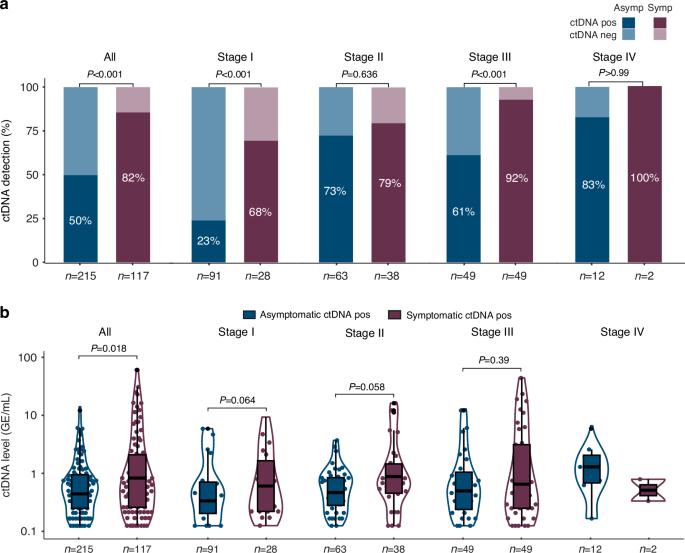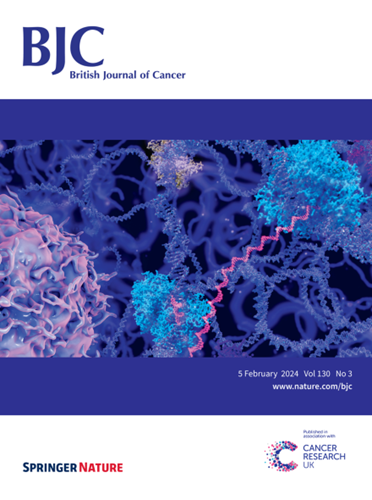Circulating tumour DNA and risk of recurrence in patients with asymptomatic versus symptomatic colorectal cancer
IF 6.4
1区 医学
Q1 ONCOLOGY
引用次数: 0
Abstract
Multiple initiatives aim to develop circulating tumour DNA (ctDNA) tests for early cancer detection in asymptomatic individuals. The few studies describing ctDNA-testing in both asymptomatic and symptomatic patients report lower ctDNA detection in the asymptomatic patients. Here, we explore if asymptomatic patients differ from symptomatic patients e.g. by including a ‘low-ctDNA-shedding’ and ‘less-aggressive’ subgroup. ctDNA assessment was performed in two independent cohorts of consecutively recruited patients with asymptomatic colorectal cancer (CRC) (Cohort#1: n = 215, Cohort#2: n = 368) and symptomatic CRC (Cohort#1: n = 117, Cohort#2: n = 722). After adjusting for tumour stage and size, the odds of ctDNA detection was significantly lower in asymptomatic patients compared to symptomatic patients (Cohort#1: OR: 0.4, 95%CI: 0.2–0.8, Cohort#2: OR: 0.7, 95%CI: 0.5–0.9). Further, the recurrence risk was lower in asymptomatic patients (Cohort#1: sHR: 0.6, 95%CI: 0.3–1.2, Cohort#2: sHR: 0.6, 95%CI: 0.4–1.0). Notably, ctDNA-negative asymptomatic patients had the lowest recurrence risk compared to the symptomatic patients (Cohort#1: sHR: 0.2, 95%CI: 0.1–0.6, Cohort#2: sHR: 0.3, 95%CI: 0.2–0.6). Our study suggests that asymptomatic patients are enriched for a ‘low-ctDNA-shedding-low-recurrence-risk’ subgroup. Such insights are needed to guide ctDNA-based early-detection initiatives and should prompt discussions about de-escalation of therapy and follow-up for ctDNA-negative asymptomatic CRC patients.

无症状与有症状结直肠癌患者的循环肿瘤 DNA 与复发风险。
背景:多项研究旨在开发循环肿瘤 DNA(ctDNA)检测方法,用于无症状人群的早期癌症检测。对无症状和有症状患者进行ctDNA检测的少数研究报告显示,无症状患者的ctDNA检测率较低。在此,我们探讨了无症状患者与有症状患者是否存在差异,例如是否包括 "低ctDNA脱落 "和 "侵袭性较低 "的亚组。方法:对连续招募的无症状结直肠癌(CRC)(Cohort#1:n = 215,Cohort#2:n = 368)和有症状结直肠癌(CRC)(Cohort#1:n = 117,Cohort#2:n = 722)患者的两个独立队列进行ctDNA评估:调整肿瘤分期和大小后,无症状患者检测到ctDNA的几率明显低于有症状患者(队列#1:OR:0.4,95%CI:0.2-0.8;队列#2:OR:0.7,95%CI:0.5-0.9)。此外,无症状患者的复发风险较低(队列#1:sHR:0.6,95%CI:0.3-1.2;队列#2:sHR:0.6,95%CI:0.4-1.0)。值得注意的是,与无症状患者相比,ctDNA阴性的无症状患者复发风险最低(队列#1:sHR:0.2,95%CI:0.1-0.6;队列#2:sHR:0.3,95%CI:0.2-0.6):我们的研究表明,无症状患者中富含 "低ctDNA脱落-低复发风险 "亚群。我们的研究表明,无症状患者中富含 "低ctDNA脱落、低复发风险 "亚群,需要这样的见解来指导基于ctDNA的早期检测措施,并应促使对ctDNA阴性的无症状CRC患者进行降级治疗和随访的讨论。
本文章由计算机程序翻译,如有差异,请以英文原文为准。
求助全文
约1分钟内获得全文
求助全文
来源期刊

British Journal of Cancer
医学-肿瘤学
CiteScore
15.10
自引率
1.10%
发文量
383
审稿时长
6 months
期刊介绍:
The British Journal of Cancer is one of the most-cited general cancer journals, publishing significant advances in translational and clinical cancer research.It also publishes high-quality reviews and thought-provoking comment on all aspects of cancer prevention,diagnosis and treatment.
 求助内容:
求助内容: 应助结果提醒方式:
应助结果提醒方式:


